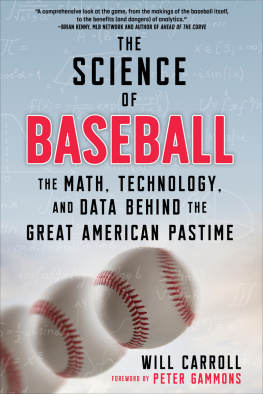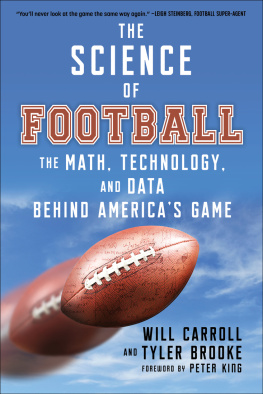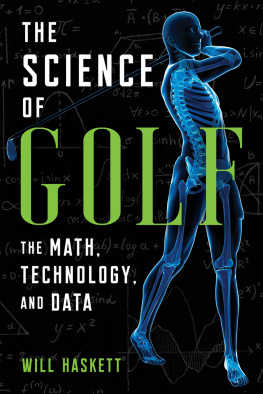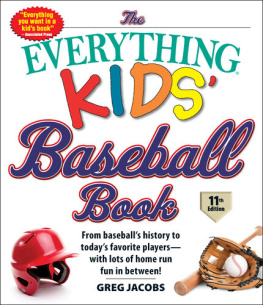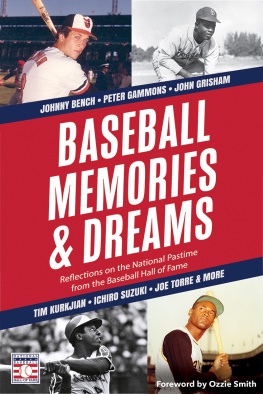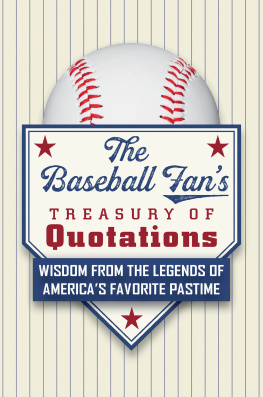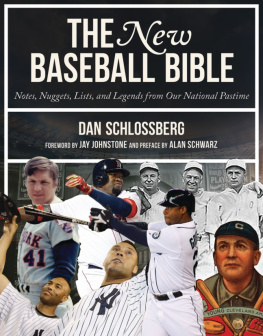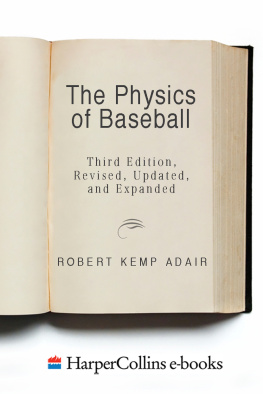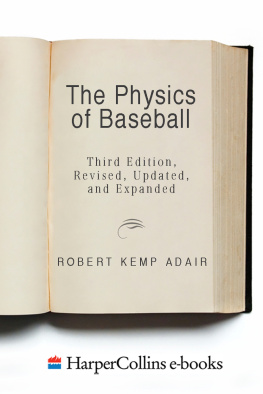
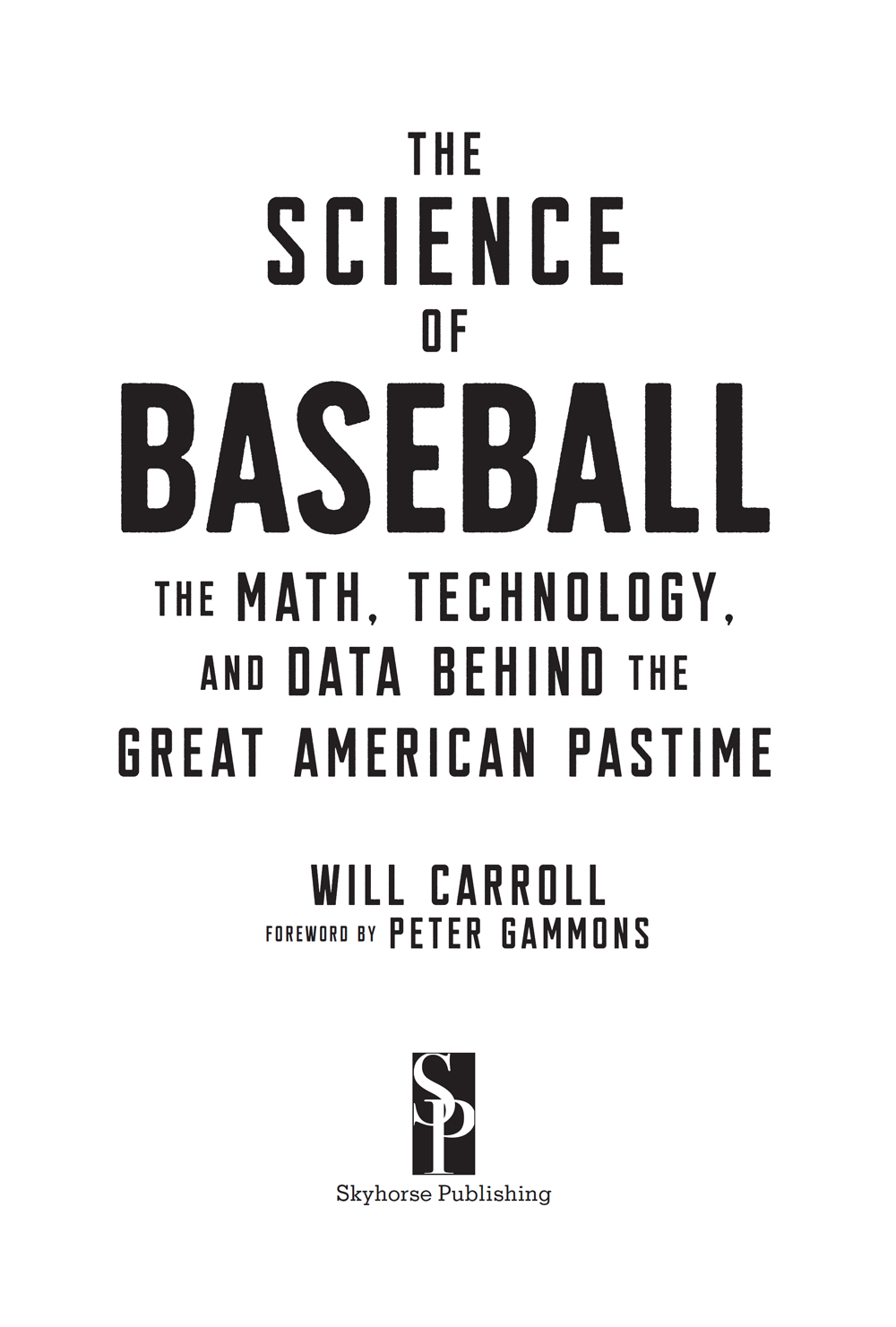
Copyright Will Carroll 2022
Foreword Peter Gammons 2022
All rights reserved. No part of this book may be reproduced in any manner without the express written consent of the publisher, except in the case of brief excerpts in critical reviews or articles. All inquiries should be addressed to Skyhorse Publishing, 307 West 36th Street, 11th Floor, New York, NY 10018.
Skyhorse Publishing books may be purchased in bulk at special discounts for sales promotion, corporate gifts, fund-raising, or educational purposes. Special editions can also be created to specifications. For details, contact the Special Sales Department, Skyhorse Publishing, 307 West 36th Street, 11th Floor, New York, NY 10018 or .
Skyhorse and Skyhorse Publishing are registered trademarks of Skyhorse Publishing, Inc., a Delaware corporation.
Visit our website at www.skyhorsepublishing.com.
10 9 8 7 6 5 4 3 2 1
Library of Congress Cataloging-in-Publication Data is available on file.
Cover design by David Ter-Avanesyan
Cover images: baseball background by Getty Images; math overlay by Shutterstock
ISBN: 978-1-5107-6897-0
Ebook ISBN: 978-1-5107-6898-7
Printed in the United States of America
CONTENTS
FOREWORD BY PETER GAMMONS
I dont remember when I became aware of Will Carroll. He said I mentioned him on the Tony Kornheiser Show on ESPN Radio around 2002, which was before he began writing for Baseball Prospectus. Anyone who has ever covered sports understands that injuries and all health issues have been a major part of the individual and team performances that the media and fans care about, and when we hear casual mention of oblique pulls, ulnar neuritis, or slap tears, we liberal arts majors have no idea of the long-term ramifications of those injuries, or, as is often the case, what part of the anatomy is impacted.
So, whenever I first read Under The Knife, Carrolls column about baseball injuries, I always seemed to learn something from it.
We are all prisoners of the mysteries, as teams from Major League Baseball to the National Football League to Southeastern Conference Football refuse to discuss or even acknowledge injuries. Some of it is that most managers and coaches believe there is an advantage in opposing teams not knowing the extent of individual injuries. There certainly was a strategy and element of surprise in the first game of the World Series when Kirk Gibson hobbled out of the Dodger dugout to bat against Dennis Eckersley, and thirty-three years later up the California Coast the Dodgers had given mixed signals about whether or not Max Scherzer could come out of the bullpen to try to finish off the deciding game of the National League Division Series. The bullpen gate opened, and Scherzer came out as if he were auditioning for the Running of the Bulls and finished the bottom of the 9th inning.
We see players leave games, and teams often issue updates referring to upper body or lower body injuries, with general timeframes for whatever the injury must entail. Then when my eyes and mind were opened to Carroll, two things immediately came to mind: Will understands medical science, orthopedics, osteoporosis, and how injuries apply to what a Ted Williams or Joey Votto understands is the supply line connection from the foot though the hips and core to the fingertips in hitting a baseball, or everything involved in the kinetic chain in throwing a baseball.
In other words, he is a man who has studied, listened, and learned a complex field. But equally as important, Carroll is a journalist who is not only an excellent reporter, but for the two decades he has been my guide, he has built a combination of respect for his work and trust from the doctors, trainers, and rehabilitation specialists and doctors to avoid general speculation and know what the athlete is doing to address the injury. For instance, in the 2021 NLDS between the Giants and Dodgers, there was speculation that injured Giants first baseman Brandon Belt might make a dramatic Kirk Gibson appearance at some critical point in the series.
Carroll wrote Belt continues to do some baseball activities, like fielding grounders in front of everybodythats not the issue for Belt. Holding a bat, now thats an issue, and we still havent seen him do it. With the win-or-go-home game down to its final out and Scherzer due to pitch to Wilmer Floreswho had never had a hit against Scherzerwe knew from Carroll that there was no Kirk Gibson alternative, or drama.
When a Noah Syndegaard or Carlos Carrasco is rehabbing, Carroll has the contacts to present the stage and the predictable timetable for their returns. During the 2021 season, when the rehabs of Chris Sale, Jacob deGrom, and Yu Darvish were significant factors, not only was Carrolls information detailed and accurate, but for the rest of us still wondering the whys and whynots, he translated.
Coming from one whose first full season covering Major League Baseball for the Boston Globe was 1972, and hence covered the first labor strike four weeks into my first spring training in scenic Winter Haven, Florida, Carrolls work over two decades has been a resource, if not a kind of sourcebook because of his scholarship, his contacts, and the trust he has earned in getting information. The Science of Baseball involves science that fascinates us allwhy curveballs break, why grips and fingers determine fastball movement. About fifteen years ago Manny Ramirez was describing why he felt out of sync when he swung and was in a slump, and when I asked, Are you trying to refigure the connection of your left foot to the fingertips on your right hand? he replied, Exactly, and Carroll can explain that.
We hear about the technology that is so prevalent in baseball, in pitch design and tracking, in the Rapsodo and Edgertronic technology as well as the video used to allow application of the appropriate biomechanics to individual bodies to create the most efficient athletic movement. Carroll allows us to understand the physics, technology, and biomechanics that go into why Max Fried is so successful a pitcher, why Walker Buehler could have Tommy John Surgery and then embark on a brilliant career, and how Juan Sotos eyesight and inherent tracking system lets him know what pitch is being thrown as it is released.
There was a time when players and coaches liked to simplify hitting down to see the ball, hit the ball. But it never was simple. Don Mattingly has always said, Ted Williams and Barry Bonds saw things no one else could see. That is fascinating. So is watching elite hitters two hours before a game taking batting practice with a small camera or even a phone camera attached to the netting of the home plate cage, and how a meticulous hitting student like J.D. Martinez may feel something in his swing is awry, takes the camera in, and studies the video in the indoor cages.
When I first pulled into Winter Haven, Florida, in March 1972, as someone three years and a month into my tenure at the Boston Globe to begin my professional life, it was a glorious day, even if it brought me to the shore of Lake Lulu. The culture, demographics, revenue, media, and venues that once seemed fresh now seem primitive.
A wonderful baseball player and lifer named Jim Fregosi gave this advice to a young scout thirty years after that: If you dont love the game of baseball and love players, find another profession first thing in the morning. That is the basis of why people like Will Carroll and I go to the park hoping to learn two things we did not know.
Next page
